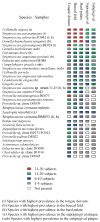Diversity and site-specificity of the oral microflora in the elderly
- PMID: 19373498
- PMCID: PMC2821189
- DOI: 10.1007/s10096-009-0743-3
Diversity and site-specificity of the oral microflora in the elderly
Abstract
The purpose of the present study was to describe the bacterial diversity in the oral cavity of the elderly without root caries using bacterial microarrays, and to determine the site- and subject-specificity of bacterial colonization. Samples were collected from the tongue dorsum, mucosa of the buccal fold, hard palate, supragingival plaque from sound root surfaces, and subgingival plaque from the same roots. A new 16 S rRNA gene-based microarray method was used for the simultaneous detection of approximately 300 bacterial species. Overall, 175 species and clusters were detected, representing eight phyla. Species belonging to the genera Streptococcus, Veillonella, and Fusobacterium were common in all sites. The number of species per subject varied from 51 to 81. Statistical analyses revealed about 40 species or clusters with significant associations with at least one of the sites. The bacterial diversity was highest in the cheek and palate regions. Species typically associated with caries and periodontitis were detected rarely or not at all. The oral bacterial flora of the elderly appears to be diverse, and, to a large extent, site- rather than subject-specific.
Figures


References
-
- Marsh PD, Martin MV. Oral microbiology. 3. Chapman & Hall; London: 1992.
-
- Amerongen AV, Veerman EC. Saliva--the defender of the oral cavity. Oral Dis. 2002;8:12–22. - PubMed
-
- Saltzman RL, Peterson PK. Immunodeficiency of the elderly. Rev Infect Dis. 1987;9:1127–1139. - PubMed
-
- Fure S. Five-year incidence of caries, salivary and microbial conditions in 60-, 70- and 80-year-old Swedish individuals. Caries Res. 1998;32:166–174. - PubMed
Publication types
MeSH terms
Substances
Grants and funding
LinkOut - more resources
Full Text Sources
Other Literature Sources

